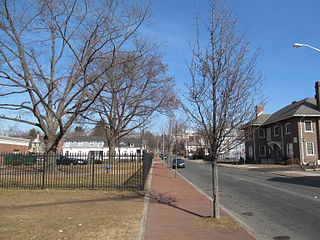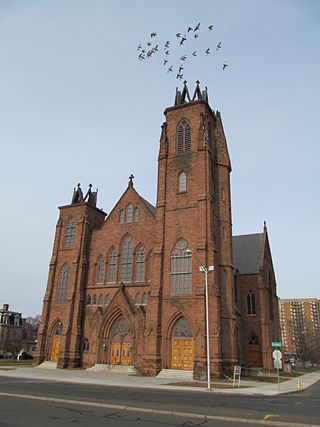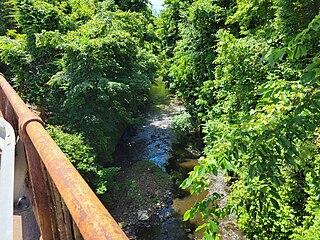
Hampden County is a non-governmental county located in the Pioneer Valley of the U.S. state of Massachusetts, in the United States. As of the 2020 census, Hampden County's population was 465,825. Its traditional county seat is Springfield, the Connecticut River Valley's largest city, and economic and cultural capital; with an estimated population of 154,758, approximately one-third of Hampden County residents live in Springfield.

Forest Park in Springfield, Massachusetts, is one of the largest urban, municipal parks in the United States, covering 735 acres (297 ha) of land overlooking the Connecticut River. Forest Park features a zoo, aquatic gardens, and outdoor amphitheater, in addition to design elements like winding wooded trails, and surprising, expansive views. The site of America's first public, municipal swimming pool, currently, during the holiday months Forest Park hosts a popular high-tech lighting display, known as Bright Nights. Contrary to popular belief, the park was not designed by Frederick Law Olmsted, although it was designed by his firm.

Mulberry Street is a historic street and tourist destination in Springfield, Massachusetts. Made famous by Dr. Seuss' first children's book And to Think That I Saw It on Mulberry Street, the street is less than one mile from Springfield's Metro Center neighborhood, the Springfield Armory, and the Quadrangle. It is also less than one mile southwest of Dr. Seuss' boyhood home on Fairfield Street.

Metro Center is the original colonial settlement of Springfield, Massachusetts, United States, located beside a bend in the Connecticut River. As of 2019, Metro Center features a majority of Western Massachusetts' most important cultural, business, and civic venues. Metro Center includes Springfield's Central Business District, its Club Quarter, its government center, its convention headquarters, and in recent years, it has become an increasingly popular residential district, especially among young professionals, empty-nesters, and creative types, with a population of approximately 7,000 (2010.)

East Forest Park is a neighborhood in the south-central part of Springfield, Massachusetts. The neighborhood borders East Longmeadow, Forest Park, and the Sixteen Acres neighborhood. It is a primarily residential middle-class neighborhood.

Indian Orchard is a village in Springfield, Massachusetts. Located in the northeast corner of Springfield, next to the Chicopee River, Indian Orchard is the city's fifth largest neighborhood.

Liberty Heights is a neighborhood in Springfield, Massachusetts, named for its main thoroughfare of Liberty Street.
The Six Corners and Maple Heights neighborhoods are located in Springfield, Massachusetts. They are often combined for political purposes, although they feature dramatically different political and socioeconomic characteristics.

Pine Point is a neighborhood in Springfield, Massachusetts. Located along Boston Road -- one of Springfield's commercial thoroughfares, was home to the Eastfield Mall -- the middle-class Pine Point neighborhoods features streets of cozy capes and ranches as well as some of the most interesting Craftsman style bungalows in the region.
Boston Road is Springfield, Massachusetts's principal commercial and retail corridor, located on the eastern edge of the city. The Boston Road neighborhood, historically known as Springfield Plain, is named for being a major waypoint on the Boston Post Road system.
The McKnight National Register Historic District is a neighborhood of Springfield, Massachusetts, and was one of the first planned residential neighborhoods in the United States. It is one of the city's smallest neighborhoods, at 306.5 acres.

The North End of Springfield, Massachusetts, is a name that describes three distinct Springfield neighborhoods: Brightwood, Memorial Square, and Liberty Heights. For more than a century, Springfield's North End neighborhood has served as a first home for some of the city's various immigrant communities, from Greeks in Memorial Square to Russians in Liberty Heights. As of 2011, the contemporary Puerto Rican flavor of the North End is evident in numerous banners depicting traditional Carnival masks and the coquí, Puerto Rico's unofficial mascot.

South End is a neighborhood in the city of Springfield, Massachusetts. Interstate 91 separates it from the Connecticut River and the Basketball Hall of Fame museum and entertainment complex.

The Brightwood neighborhood of Springfield, Massachusetts, is located in the northwest corner of the city, along the Connecticut River; however, it is separated from the rest of Springfield by the Interstate 91 elevated highway. Many recent academic papers at the University of Massachusetts Amherst' School of Urban Design have focused on the detrimental physical and sociological effects that Interstate 91 has had on the Brightwood neighborhood and on Springfield in general.

The Bay neighborhood is located in Springfield, Massachusetts. It covers 556.5 acres of land, making it one of the city's smallest neighborhoods.
Old Hill is one of the seventeen neighborhoods of Springfield, Massachusetts. It is composed, almost entirely, of Victorian buildings overlooking Springfield's Metro Center.

Sixteen Acres is a neighborhood in Springfield, Massachusetts. Much of the neighborhood was constructed after World War II and is suburban in character. Unlike what its name might suggest, the neighborhood covers 4,506 acres.

Merrick is a neighborhood in the southeast corner of West Springfield, Massachusetts. Borders are, Park Ave to the north, Union St. and its industrial buildings to the west, and Bridge St. to the south and U.S. Route 5. Downtown is to the north and northwest and the neighborhood Memorial, is to the south and southwest. The Connecticut River is to the east. The population as of 2010 was 2,986.

The Mill River is a 1.25-mile-long (2.01 km) tributary of the Connecticut River in Springfield, Massachusetts. It flows from Watershops Pond to its confluence with the Connecticut River. It is referred to as "The Miracle Mile" in a 2009 master's thesis that outlines possibilities for reclaiming the river's mouth as a recreational area. As of 2011, the final 350 feet (110 m) of the river, including its mouth, is confined in a pipe underneath Interstate 91, railroad tracks and a car dealership. Many Springfield residents have bemoaned the loss of the Mill River as a recreational area, and hope to gain greater access to both it and the Connecticut River in upcoming years. As it has for over a century, today the Mill River serves as a barrier between Springfield neighborhoods. Surrounding it are some of the most densely urbanized locations in Springfield.
















